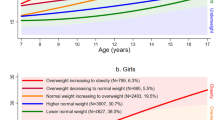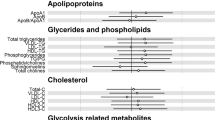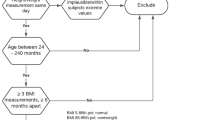Abstract
OBJECTIVE: A global epidemic of obesity is developing, but its causes are still unclear. In Denmark, two periods of steep increases in prevalence of obesity have occurred among young men born in the 1940s and 1960–70s. This study investigated the preceding changes in prevalence of obesity and in the entire body mass index (BMI=weight/height2) distribution by birth cohort, calendar time and age among Danish school boys.
METHODS: Children attending Copenhagen schools 1937–1983 had annual health examinations, from which we computerized 1 037 468 measurements of height (m) and weight (kg) of 161 314 boys aged 7–13 y. Obesity was defined as age-specific BMI exceeding the 95.0, the 99.0 and the 99.9 percentile among those born 1930–1934, the latter corresponding to the prevalence of obesity among the young men in these cohorts. The median, standard deviation, skewness, and the 5th, 25th, 75th and 95th percentiles of the age-specific BMI were estimated for each birth cohort.
RESULTS: The prevalence of obesity, defined by the 99.9 percentile, increased at all ages during the same birth years as among the young men, and, accordingly, at earlier calendar years. The prevalence of obesity, defined by the 95.0 percentile, showed a distinctly different pattern: a sharp increase, irrespective of age, during the calendar years 1947–1949, and thereafter a stable level until the 1970s, where a further modest increase began. The prevalence defined by the 99.0 percentile showed a mixture of the trends in those defined by the 99.9 and 95.0 percentiles. The median BMI showed small fluctuations, parallel at all ages. The standard deviation and right-sided skewness increased until birth year 1950, but were almost stable thereafter. The pattern of changes in the quartiles mostly reflected those in the median.
CONCLUSIONS: The prevalence of obesity defined by the 99.9 or 99.0 percentile has increased in Danish boys born in the 1940s and since the mid 1960s, without corresponding changes in the central part of the BMI distribution. When defining obesity by the 95.0 percentile, there was a sharp distinct age-independent increase in the late 1940s.
The development of the obesity epidemic is a heterogeneous phenomenon that has involved changes in environmental influences starting at preschool ages and affecting different subsets of the population, either because of selective exposure or particular susceptibility.
This is a preview of subscription content, access via your institution
Access options
Subscribe to this journal
Receive 12 print issues and online access
$259.00 per year
only $21.58 per issue
Buy this article
- Purchase on SpringerLink
- Instant access to full article PDF
Prices may be subject to local taxes which are calculated during checkout
Similar content being viewed by others
Author information
Authors and Affiliations
Corresponding author
Rights and permissions
About this article
Cite this article
Thomsen, B., Ekstrøm, C. & Sørensen, T. Development of the obesity epidemic in Denmark: Cohort, time and age effects among boys born 1930–1975. Int J Obes 23, 693–701 (1999). https://doi.org/10.1038/sj.ijo.0800907
Received:
Revised:
Accepted:
Published:
Issue date:
DOI: https://doi.org/10.1038/sj.ijo.0800907
Keywords
This article is cited by
-
A break in the obesity epidemic? Explained by biases or misinterpretation of the data?
International Journal of Obesity (2015)
-
The pathophysiology of hypertension in patients with obesity
Nature Reviews Endocrinology (2014)
-
Risk factors for childhood overweight: shift of the mean body mass index and shift of the upper percentiles: results from a cross-sectional study
International Journal of Obesity (2010)
-
Risk factors for childhood obesity: shift of the entire BMI distribution vs. shift of the upper tail only in a cross sectional study
BMC Public Health (2008)
-
Secular Trends in Childhood Obesity in Denmark During 50 Years in Relation to Economic Growth
Obesity (2007)



